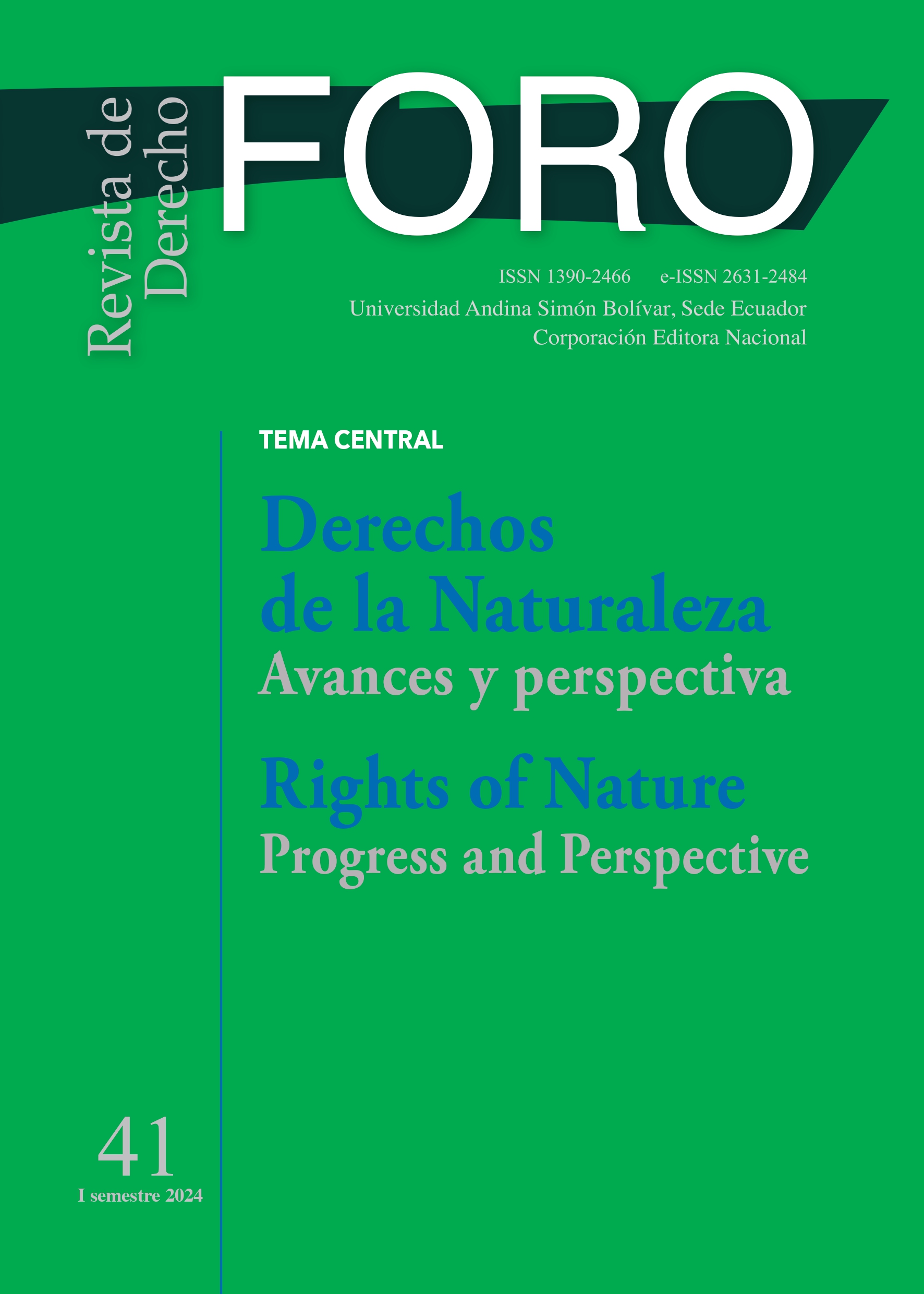The Rights of Nature: “Manglares” and “Bosque Protector Los Cedros” Judgments
DOI:
https://doi.org/10.32719/26312484.2024.41.2Keywords:
rights, nature, ecosystems, environment, water, mangroves, Los Cedros, EcuadorAbstract
This article analysis the decisions of the Constitutional Court in the “Manglares” case and in the “Bosque Protector Los Cedros” case. The analysis extracts the elements of the rights of nature in the Ecuadorian constitution and compares them with the decisions of the Constitutional Court. In order to carry out this exercise, a critical analysis of the judgments was used. It compares what was developed with the concepts used by the natural sciences and determines whether the concepts developed can be improved and which of these concepts have yet to be developed by the Court. This comparison showed that it is necessary to continue developing a deeper dialogue with the natural sciences in order to understand and explain the elements of nature. The current Constitution of Ecuador incorporated the rights of nature for the frst time in our constitutional history. Despite some favorable rulings by judges of frst instance and Provincial Courts, the Constitutional Court, the highest body of consti tutional justice in the country, had not issued rulings that develop these rights until recently.
Downloads
References
Ávila Santamaría, Ramiro. “El derecho de la naturaleza: fundamentos”. En Los derechos de la naturaleza y la naturaleza de sus derechos, editado por Carlos Espinosa Gallegos-Anda y Camilo Pérez Fernández, 35-73. Quito: Ministerio de Justicia, Derechos Humanos y Cultos, 2011. bit.ly/41KXfWT.
---. “La teoría sistémica del derecho en la jurisprudencia de la Corte Constitucional”. Ecuador Debate, n.º 116 (agosto 2022). bit.ly/3L8HPWg.
---. La utopía del oprimido. Bogotá: UASB-E/Akal, 2019.
Capas de la Tierra. “Biosfera”. Accedido 24 de febrero de 2022. bit.ly/3LgrxtT.
Conciencia Eco. “¿Qué es un ecotono?”. Accedido 28 de febrero de 2022. bit.ly/449Eazl.
Cullinan, Cormac. Derecho Salvaje. Quito: Huaponi Ediciones, 2019.
Ecuador. Constitución de la República del Ecuador. Registro Ofcial 449, 20 de octubre de 2008.
Ecuador Corte Constitucional. “Sentencia”. Caso n.° 0567-08-RA. 16 de julio de 2009.
---. “Sentencia”. Caso n.° 32-17-IN/21. 9 de junio de 2021.
---. “Sentencia”. Caso n.° 22-18-IN/21. 8 de septiembre de 2021.
---. “Sentencia”. Caso n.° 1149-19-JP/21. 10 de noviembre de 2021.
---. “Sentencia”. Caso n.° 1185-20-JP/21. 15 de diciembre de 2021.
---. “Sentencia”. Caso n.° 2167-21-EP/22. 19 de enero de 2022.
---. “Sentencia”. Caso n.° 253-20-JH/22. 27 de enero de 2022.
Ecuador Corte Provincial de Justicia de Loja, Sala Penal. “Sentencia”. En Juicio n.° 11121-2011-0010. 30 de marzo 2011.
Ecuador Corte Provincial de Justicia de Loja. “Sentencia”. En Juicio n.° 11333-2021-01687. 10 de febrero de 2022.
Ecuador. Ley Orgánica de Garantías Jurisdiccionales y Control Constitucional. Registro Ofcial 52, Suplemento, 22 de octubre de 2009.
Ecuador. Ley Orgánica de Recursos Hídricos Usos y Aprovechamiento del Agua. Registro Ofcial 305, Suplemento, 6 de agosto de 2014.
Ecuador Unidad Judicial Multicompetente de Cotacachi. “Sentencia”. En Proceso n.º 10332-2021-00937. 11 de febrero de 2022.
Estupiñán Achury, Liliana, Claudia Storini, Rubén Dalmau Martínez y Fernando Antonio de Carvalho Dantas, eds. La naturaleza como sujeto de derechos en el constitucionalismo democrático. Bogotá: Universidad Libre, 2019. https://doi.org/10.18041/978-958-5578-09-8. DOI: https://doi.org/10.18041/978-958-5578-09-8
Ferrajoli, Luigi, Luca Baccelli y Antonio de Cabo, eds. Los fundamentos de los derechos fundamentales. Madrid: Trotta, 2001.
Hunter, David, James Salzman y Zaelke Durwood. International Environmental Law and Policy. 4.ª ed. Nueva York: Foundation Press, 2011.
IPCC. “IPCC WGII Sixth Assessment Report Summary For Policymakers.pdf”. Accedido 3 de marzo de 2022. bit.ly/4275Tis.
Nino, Carlos Santiago. Introducción al análisis del derecho. Buenos Aires: Astrea, 2010.
Noss, Reed F. “Indicators for Monitoring Biodiversity: A Hierarchical Approach”.Conservation Biology4, n.o4 (diciembre 1990): 355-64. https://doi.org/10.1111/j.1523-1739.1990.tb00309.x. DOI: https://doi.org/10.1111/j.1523-1739.1990.tb00309.x
Noticias ONU. “La naturaleza debe regir la toma de decisiones si queremos sobrevivir”. 18 de febrero de 2021. bit.ly/3oRJS91. ONU Cumbre de la Tierra. Convenio sobre la diversidad biológica. 29 de diciembre de 1993. bit.ly/3L7IDK4.
Pacheco, Máximo. Teoría del Derecho. 4.ª ed. Santiago: Editorial Jurídica de Chile, 1993.
Papa Francisco. “Carta encíclica Laudato Si’ del santo padre Francisco sobre el cuidado de la casa común”. Accedido 13 de febrero de 2022. bit.ly/3Hi1a5C.
Prado Llanchi, Guillermo Patricio. “Derechos al ambiente sano y de la naturaleza: límites y aproximaciones conceptuales”. 2020. bit.ly/4270mZ7.
UNFCC. “UNFCCC Annual Report 2020”. 24 de mayo de 2015. bit.ly/3LEFWBx.
Verdezoto, Gabriela. “El fn de los manglares del Golfo”. GK City. 5 de enero de 2022. bit.ly/41KsvFI.
Virginia Tech. Leading conservation biologist and naturalist Reed Noss to visit Virginia Tech. 2 de octubre de 2016. bit.ly/3VlRpco.
Wulf, Andrea. La invención de la naturaleza. Bogotá: Penguin Random House Grupo Editorial, 2017.
Downloads
Published
How to Cite
Issue
Section
License
Copyright (c) 2024 Foro: Law Journal

This work is licensed under a Creative Commons Attribution-NonCommercial-ShareAlike 4.0 International License.
CESIÓN DE DERECHOS, DECLARACIÓN DE CONFLICTO DE INTERESES Y DIFUSIÓN
Los autores/as que publiquen en esta revista aceptan las siguientes condiciones:
- Los autores ceden a la Foro: Revista de Derecho, el derecho de la primera publicación. Las obras se publican en la edición electrónica e impresa de la revista bajo una Licencia Creative Commons 4.0 de Reconocimiento No Comercial-Compartir Igual 4.0, que habilita a compartir, adaptar y atribuir el trabajo (ver: Políticas de acceso abierto).
- Ver información completa de cesión de derechos, declaración de conflicto de intereses y difusión, aquí







